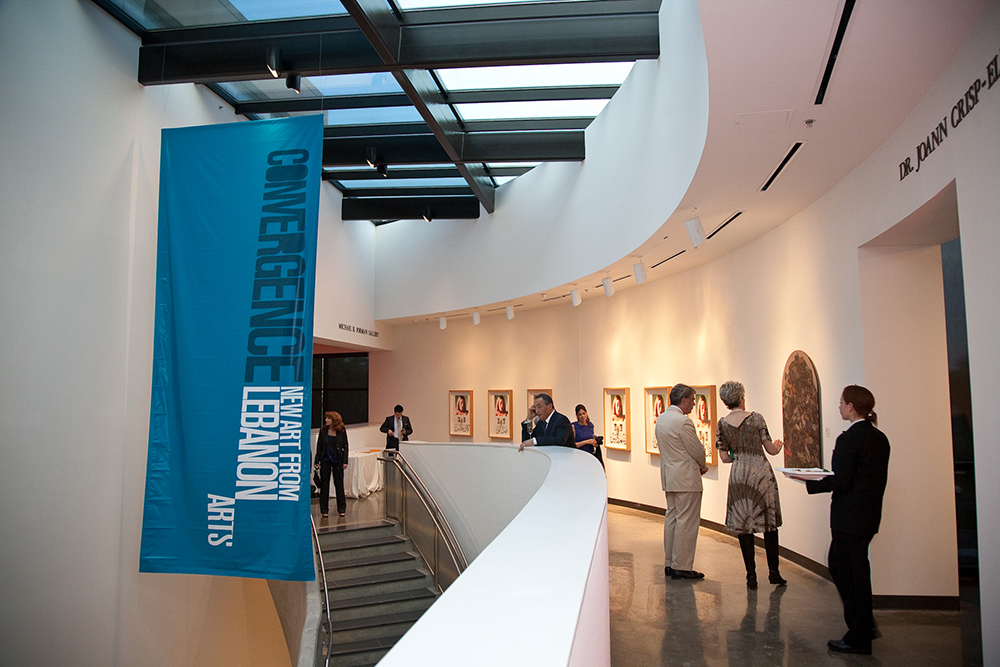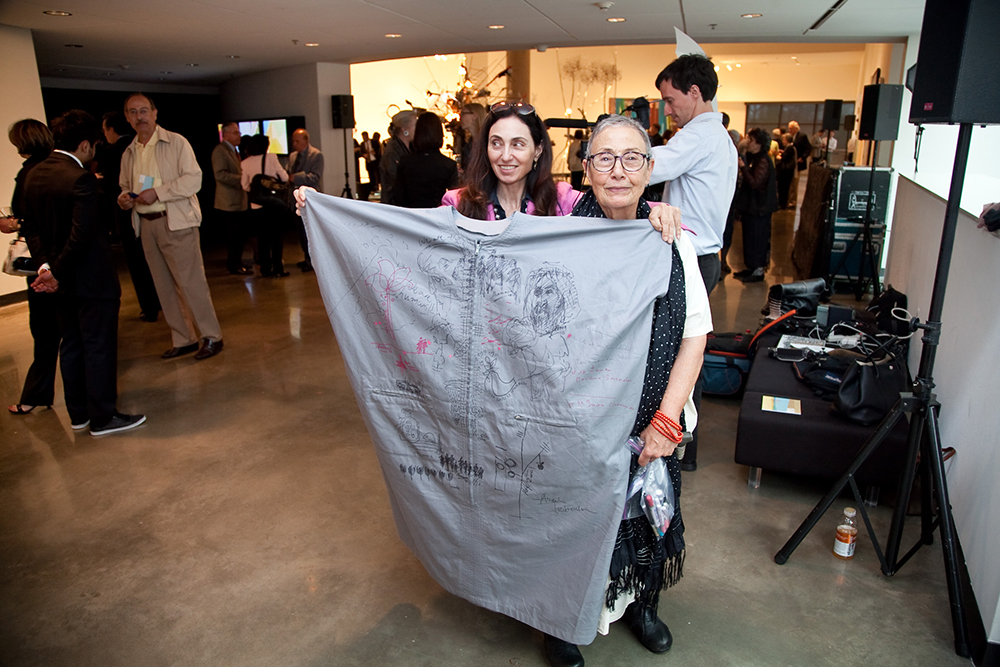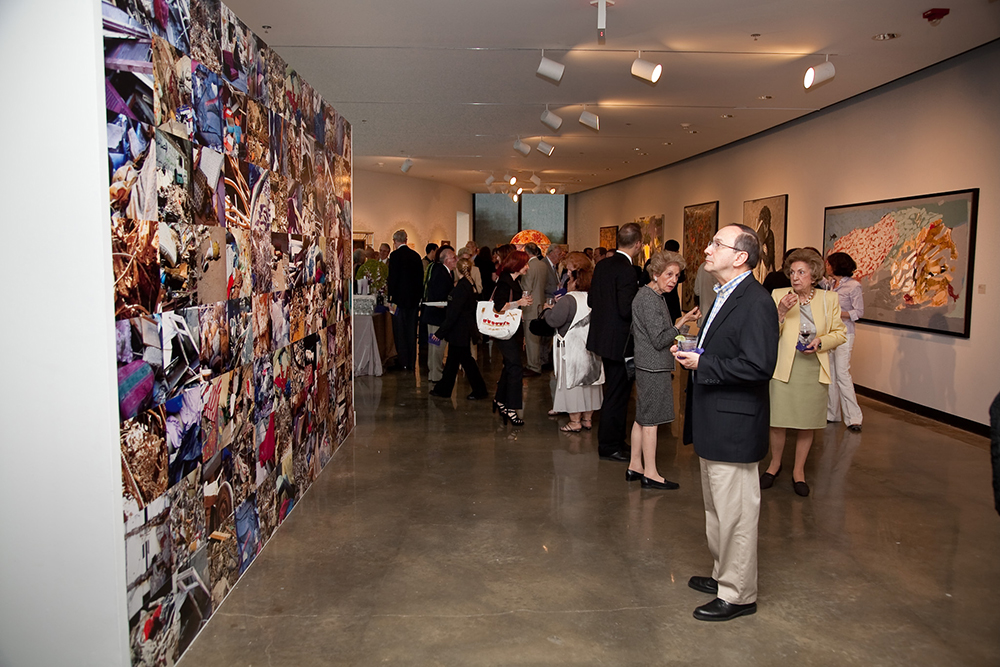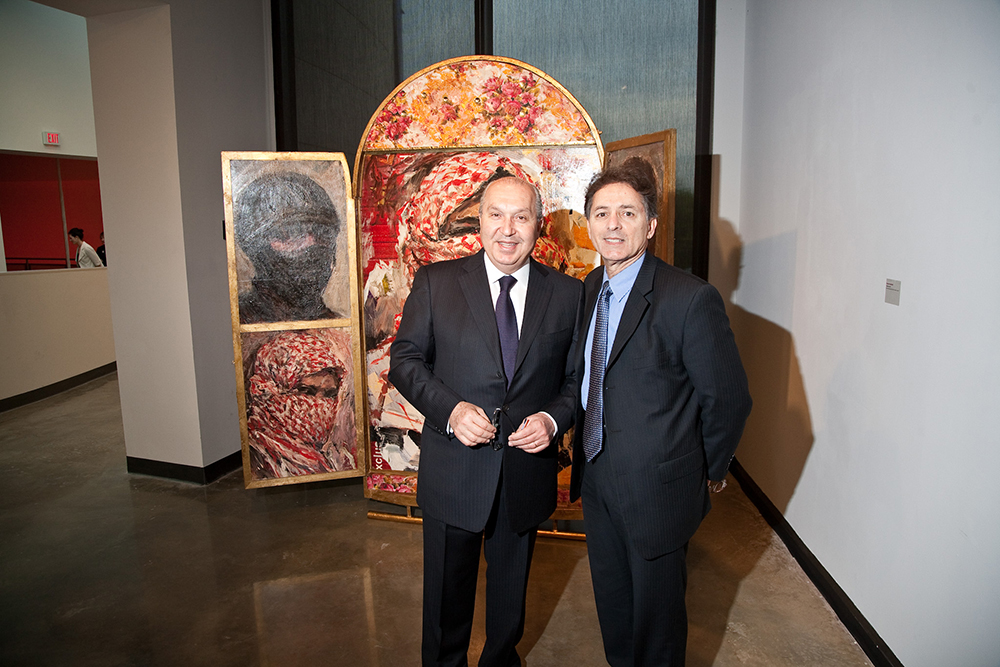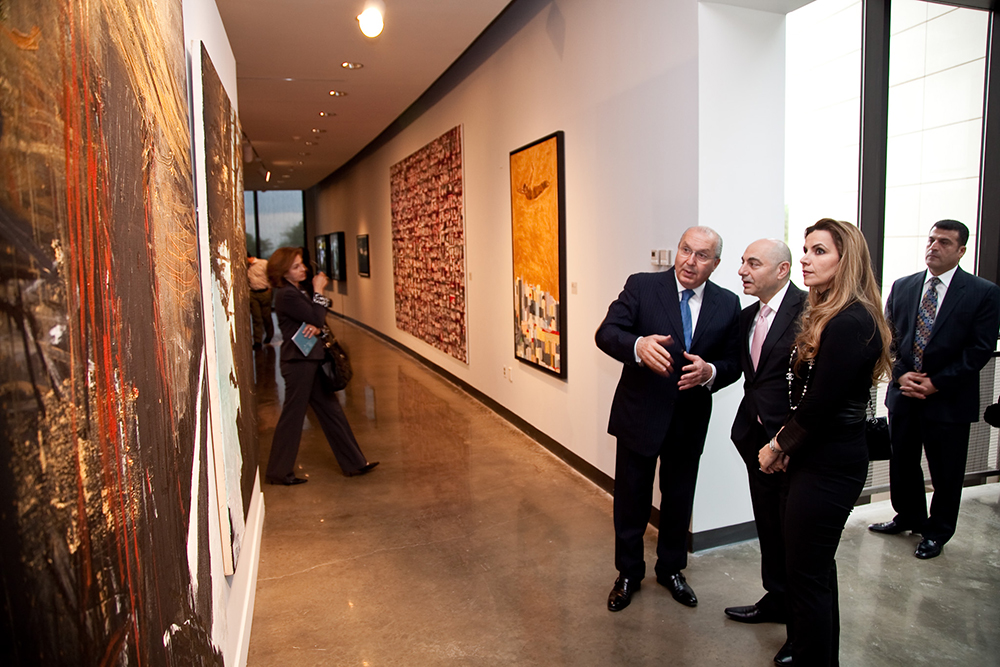The first comprehensive North American exhibition curated in the aftermath of Lebanon’s tumultuous civil war (1975-1990), Convergence brought together nearly 50 paintings, sculptures, installations, photographs and media-based art by 29 artists—more than a third of them women— based primarily in Beirut. Reflecting the memories, hopes, dreams and political and religious realities of a culture seeking to reclaim itself, the exhibition introduced Americans to the vitality and volatility of today’s art from Lebanon.
Convergence was held in 2010 at the Katzen Arts Center in the College of Arts and Sciences at the American University in Washington D.C.
Participating Artists:
- Ayman Baalbaki
- Oussama Baalbaki
- Lulu Baasiri
- Mouna Bassili Sehnaoui
- Huguette Caland
- Joseph Chahfe
- Chaouki Chamoun
- Hala Dabaji
- Amal Dagher
- Mansour El Habre
- Rim El Jundi
- Mohamad El Rawas
- Chawki Frenn
- Bassam Geitani
- Joseph Harb
- Joumana Jamhouri
- Nadim Karam
- Nabil Nahas
- Jean Pierre Watchi
- Jocelyne Saab
- Mario Saba
- Marwan Sahmarani
- Nada Sehnaoui
- Kris Seraphin
- Hanibal Srouji
- Anita Toutikian
- Katia Traboulsi
- Paul Wakim
Film Series
A series of six feature-length works, three short films, and one documentary representing the best in contemporary Lebanese film.
After screening discussions were led by Jeffrey Middents, a professor and director of the Cinema Studies minor and world literature at the American University in Washington DC, and Alicia Sams, an Emmy-Award winning producer and director with extensive experience in both documentary and feature films.
- NOT LIKE MY SISTER (2008) – Leyla Assaf Tengroth
- THE NORTH ROAD (2008) – Carlos Chahine
- BOSTA (2005) – Philippe Aractingi
- UNDER THE BOMBS (2007) – Philippe Aractingi
- ZOZO (2005) – Josef Fares
- QUAND MARYAM S’EST DEVOILEE (2001) – Assad Fouladkar
- AFTER SHAVE (2005) – Hany Tamba
- BEIRUT OPEN CITY (2008) – Samir Habchi
- ASHES (2003) – Joana Hadjithomas, Khalil Joreige
- THE KITE (2003) – Randa Chahal Sabag
The Kite
The film follows two star-crossed lovers from opposite ends of the Israeli-Lebanese border. Lamia, a Lebanese woman separated from the object of her affection, an Israeli patrolman named Youssef, by a maze of social and political barriers. An Arab himself, Youssef is ambivalent about guarding the border against a village occupied by his own family and relatives.
Zozo
Zozo grows up in Beirut. In spite of the civil war he leads a normal life with family, friends and classmates. But one day tragedy strikes and Zozo is torn from his family and forced to make his own way through life. His only hope is to get himself to Sweden, for him and unknown country.
Not Like My Sister
Rim Kerkatli rose to fame at the age of nine after starring in Assaf-Tengroth’s 1994 hit documentary Frihetsligan (Freedom League). The film offered Rim the opportunity to go to school, a privilege for young women from her village. But her freedom was short-lived. At the age of 13, she was forced to marry her father’s cousin. Rim’s younger sister, Dalida, does not want to share the same fate, and her struggle to defy traditional norms becomes the focus of Not Like My Sister. Filmmaker Leyla Assaf-Tengroth presents a stark documentary on forced marriage and honor killings in rural Syria.
After Shave
Mr. Raymond has lived alone in an old house in Beirut since his wife died. He is called on by Abou Milad, an old barber in the neighborhood who earns his living working out of cafés.
Under the Bombs
Zeina lives in Dubai. In the midst of a divorce, she sends her son Karim to stay with her sister in Kherbet Salem, a small village in South Lebanon, to spare him from his parents’ fighting. A few days later, war breaks out in Lebanon. Desperately worried, Zeina immediately heads to Lebanon via Turkey. Because of the blockade she does not reach the port of Beirut until the day of the ceasefire. There she meets Tony, the only taxi driver who agrees to take her to the South. Zerina and Tony set out in search of her lost child in a journey that brings them together as they encounter widespread death and destruction.
The North Road
Karim, who is in his mid-forties, has lived in France since his early teenage years. For the first time in many years he returns to Lebanon to transfer the remains of his father, who died during the war, from Beirut to his home village.
When Maryam Spoke Out
Based on a true story. A social film about a couple, Ziad and Maryam, who have a happy marriage, except that three years in, Maryam has still not had a baby. Ziad is compassionate and assures her that he still loves her. Yet Maryam cannot escape the growing pressure from the family, especially from her mother- in-law. She reacts by faking a pregnancy. Her family’s initial enthusiasm disappears when it becomes clear that Maryam and Ziad are not really expecting a baby.
Ashes
Nabil returns to Beirut with the ashes of his father who died abroad. He tries to overcome his bereavement while his family insists on respecting custom by burying a non-existent corpse.
Beirut Open City
Khaled is a young Egyptian man living in Beirut during the national reconstruction effort-a project that has fallen short of its promises and left many disillusioned. In solidarity with his fellow citizens, the aspiring filmmaker undertakes a cinematic project that reveals the dualism of modern-day Lebanon: its compassion and also its cruelty. While wandering through the city, Khaled encounters remarkable people on the streets who motivate characters in his vision. As he proceeds, however, the imaginary and the factual begin to intermingle. Eventually, Khalid finds himself a captive of the scenario he is writing and doomed to endure the fate of its characters.
Bosta
Bosta is the story of a group of dancers who perform the traditional Lebanese Dabkeh in a Techno style. After 15 years of exile in France, Kamal returns to Beirut with his mind set on one goal: to reunite the dance group he had formed with his school friends, whom he hasn’t seen since he left. But he also wants to make the bold move of introducing a Western flavor to the traditional Dabkeh. When the dancers audition before the jury of the National Dabkeh Festival, they are curtly rejected because they are disgracing the “only cultural icon left.” This prompts them to refurbish their old school bus and embark on a road trip across Lebanon to perform and introduce their pioneering dance to the public. As they struggle to win people over with their alternative spirit, each of the dancers realizes that they also embarked on a personal journey to reconnect with their childhood, their lost friendships, and the pains of the war and separation. It is a journey that leads the group of friends to turn the page on a painful past.
Moments – A Lecture by Nadim Karam
Given at the opening reception of CONVERGENCE: NEW ART FROM LEBANON
This lecture is composed as a series of moments, of issues that affected my trajectory as a person and came to be expressed as an artist. More and more I try to address communities and cities based on themes involving time, dreams and memories. I work to the scale of the city and co-operate with many of its people to realize a project. In the end the work is not absolute; it molds itself relative to the dynamics of the city. It is finished when it takes on its own life in the imagination of city dwellers.
Since we are here to celebrate the opening of an exhibition of Lebanese contemporary art in Washington, I felt the need to define what it is to be Lebanese. I found that we are best expressed by our diversity. Using a personal vocabulary I call ‘urban toys’, I experimentally replaced the cedar tree on the Lebanese flag with a multiplicity of forms, one after another. It struck me that, although its history is very different, diversity would also be the most apt word to describe America, so I transformed each of the fifty stars on the American flag. One of those stars, I suppose, would be Lebanese.
The 2006 attack on Lebanon by Israel made me think lengthily about what it means to be Lebanese. With my office closed overnight and myself later a refugee in the UK, this reflection inspired some 600 sketches and paintings.
Which takes us back to the origins of my temporary projects of urban sculptures in Beirut in the aftermath of the 17-year civil war. Returning from Japan in 1993, I found my country in ruins, the result of its people defending to the death their allegiance to different religious and political symbols. I wanted to create anti-symbols to illustrate this folly. I wanted to bring to the city a multiplicity and diversity of signs to provoke astonishment, curiosity and amusement, to break the grim attachment to symbols that had taken us beyond the brink. And, most importantly, I wanted them to be part of a moment in the city’s life; to appear, to move and then to leave.
I began with urban art installations at the Sursock Museum (1994) and the National Museum (1995); the first experimentation of urban toys in sculptural form. This was followed by itinerant installations in downtown Beirut from 1997-2000, during the upheaval of Solidere’s destruction of much of the ruins of Downtown and the intensive infrastructural works.
Then the attack of September 11, 2001 set in motion a chain of terror and fear in cities all over the world. In 2006, while Lebanon was under attack by Israel, I was printing under the bombs my book “Urban Toys”, a compilation of six different urban projects in five cities centering on the question ‘Can cities dream?’
“…There is lots of terror on earth, and there are lots of bombs in cities these days.
Cities, countries and the world are caught in a tide of nihilism whose protagonists believe that destruction is a solution. There should be a hundred times more creative effort to resist what is being negated. Cities need to dream. They were built up slowly on thousands of small dreams. Somewhere, cities should still dream. We should make them dream. In a world full of wonders and dangers, every moment is a magical survival.
We should make dream bombs in a world threatened with real bombs. Dream bombs are planned for years in advance, probably requiring as much energy, financial backing, organization and know-how as the terrorist kind. They might fail to happen, but when they do, their vitality permeates the city.”
I have selected two of my projects; those of Nara and Melbourne, and a new project in growth for Amman to give an idea of the process and thought behind the urban works.
Melbourne, Australia
‘The Travellers’ is a permanent urban art installation of ten 9m-high sculptures for the Sandridge Bridge, which I conceived in 2001 and was commissioned to realize in 2005 by the City of Melbourne and State of Victoria. Nine of the sculptures are a metaphorical re-creation of the major waves of migrants who travelled on the train from the port of Melbourne to the central Flinders Station for more than a century. Functioning as a kind of an urban clock, the sculptures travel across the bridge along rails and return three times a day, morning, noon and night. It takes 15 minutes for them to reach their places on the bridge, where they remain for an hour before returning. Gayip, the tenth sculpture, and which represents the indigenous aboriginal community, stands high on a nearby rock, watching the Travellers as they cross the Yarra River.
Nara, Japan
This project, a temporary installation in August 2004, took place in the grounds of the Todaiji Temple in Nara, site of the ancient capital of Japan. Over five hundred small sculptures and three giant ‘flowers’ were placed in Kagami Lake in homage to one of the founding monks of the temple, who according to legend, originated in the Middle East. I first presented the concept for this project to the Todaiji monks in 1984, when I was still a student doing my doctorate. After repeated presentations, I finally received approval for its realization twenty years later.
Amman, Jordan
The concept for a project-in-growth for Amman is called ‘The Dialogue of the Hills’. Amman encompasses a number of hills with distinct histories, characters and populations of varying socio-economic background. Their histories have built the city and what interested me was to create a story that could link them visually in a kind of cultural pilgrimage.
The Cloud of Dubai
The Cloud is a sustainable design initiative inspired by the city of Dubai. Standing at a height of approximately 300 meters, it is a landscape-in-the sky comprising a lake, gardens, rotating bridges, spiraling walkways and terraces, an auditorium and sky-sports platform. It stands on a myriad of slender, inclined columns designed to resemble rain. I have been working on the Cloud project with Arup Engineers in London for over two years to study the technological solutions and innovative materials that will be needed for its realization.
The Cloud is an ethereal horizontal antithesis to the rocketing of skyscrapers into Gulf skylines and a social antithesis to their elitism.
The Fisherman and the Cloud
‘The Fisherman and The Cloud’, a sculpture installation commissioned for Convergence, was part of a series of works based on a critical project for Dubai. The installation offered a panacea to the city’s numerous exclusive rooftop venues and an ode to the loss of human-scale.
The Fisherman is the Everyman. The landscape memory contained inside his body represented an accumulation of his past experiences, and the cloud above him, an abstraction of his thoughts. When the fisherman played with the Cloud, the movement created an amorphous shape, the blurred boundary illustrating the flexibility of mind and spirit. The Fisherman had five arms with which to fish. His catches were high-rise buildings, which represented human greed, technological achievement and our desire to reach the sky. With his three other arms, he played with the Cloud and the multitude of stories that it generated.
A Collaboration between APEAL-USA and The American University in Washington D.C.- April 2010


